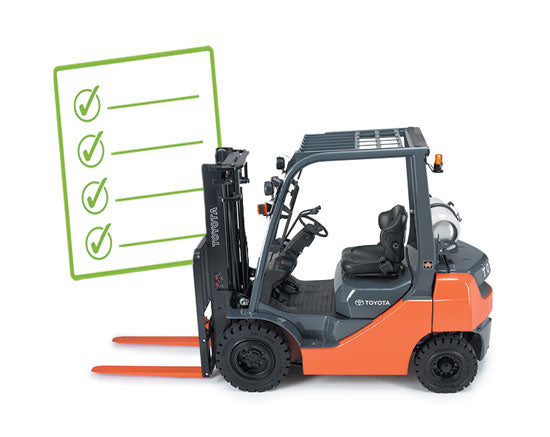
Lift Truck Safety Checks
Before beginning a shift, forklift operators should protect themselves and their co-workers from harm by conducting a simple, preflight check to make sure the lift truck is functional and in safe operating condition. An easy preflight checklist doesn’t just prevent accidents; it also keeps expensive equipment protected and maintained, which can extend the life of the lift and its component parts.
Propane and electric lift trucks require slightly varied areas of attention, but both will need a general overview first. Here are a few items to examine in order.
Fluid levels: Check for oil, water and hydraulic fluid. If levels are dropping too quickly, make a note of it.
Hydraulic hoses and mast chains: Look for leaks, cracks and defects. Check the tension of the chains. Don’t do this with your hands; instead, reach in with a stick or pole.
Tires: The tires should be sound and pressure should be within range. Check for gouges and other signs of damage.
Forks: Take a close look at the forks to make sure the heel and top clip retaining pin are in place and secure.
Safety devices: All safety elements, including seatbelts, decals, stickers and signals should be readable, operational and secure.
Manual: Ideally, the operator’s manual for the lift truck should be onboard and readable.
Considerations for Electric Lift Trucks
Be conscious of safety—including eye protection and skin protection—if you need to make contact with electrolyte levels or exposed wires. But generally, a visual inspection will suffice. Examine:
- Cable connectors for frayed and damaged wires
- Battery restraints to make sure they’re secure
- Hood latches to make sure they’re tight, and
- Electrolyte levels.
Considerations for Propane Forklifts
Propane forklifts will require a specific set of prechecks to ensure the propane tanks are secure and properly attached. As you create your standard checklist, encourage operators to look for:
- A properly mounted tank
- A pressure relief valve that is pointing up.
- Hoses and connectors are tight, in good repair, and not leaking or damaged.
- Tank restraint brackets are tight and in good repair.
- Propane tanks are neither dented nor cracked.
- Tanks that fit within the profile of the lift truck.
- A clean, dry floor under the truck; nothing should be leaking.
If operators identify any problems with the lift truck—from a non-working signal light to a loose mast chain—the truck should be removed from operation immediately and placed in service. All problems identified during the check, no matter how small, should be properly documented and pointed out to a supervisor.

